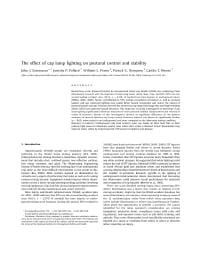Mining Publication: The Effect of Cap Lamp Lighting on Postural Control and Stability
Original creation date: July 2012
Authors: JJ Sammarco, JP Pollard, WL Porter, PG Dempsey, TC Moore
Researchers at the National Institute for Occupational Safety and Health (NIOSH) are conducting mine illumination research with the objective of improving miner safety. Slips, trips, and falls (STFs) are the second leading accident class (18.1%, n = 2,374) of nonfatal lost-time injuries at underground mines (MSHA, 2005-2009). Factors contributing to STFs include recognition of hazards as well as postural balance and age. Improved lighting may enable better hazard recognition and reduce the impact of postural balance and age. Previous research has shown that cap lamp technology that used light-emitting diodes (LEDs) has improved hazard detection. This study was an initial investigation to determine if cap lamp lighting significantly influences measures of static postural stability (displacement and velocity of center of pressure). Results of this investigation showed no significant differences in the balance measures of interest between cap lamps tested. However, balance was shown to significantly decline (p < 0.05) when tested in an underground coal mine compared to the laboratory testing condition. Relevance to industry: Underground coal mine workers wear cap lamps on their hard hats as their primary light source to illuminate nearby areas where their vision is directed. Proper illumination may improve miner safety by improving their STF hazard recognition and balance.

- Assessing and Monitoring Open Pit Mine Highwalls
- Discomfort Glare Comparison for Various LED Cap Lamps
- Experiments on Personal Equipment for Low Seam Coal Miners: IV. Incorporating Coiled Cord Into Cap Lamp Battery Cords
- Illumination
- Investigation of a Slip/Fall Accident
- Overcoming Common Slip, Trip and Fall Hazards
- Toolbox Training For Construction Aggregate Miners
- Using Major Hazard Risk Assessment to Appraise and Manage Escapeway Instability Issues: A Case Study
- Visual Performance for Incandescent and Solid-State Cap Lamps in an Underground Mining Environment
- Visual Performance for Incandescent and Solid-State Cap Lamps in an Underground Mining Environment
- Visual Performance for Trip Hazard Detection When Using Incandescent and LED Miner Cap Lamps